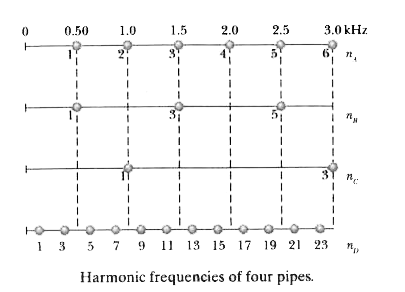Pipe A is open at both ends and has length LA = 0.343 m. We want to place it near three other pipes in which standing waves have been set up, so that the sound can set up a standing wave in pipe A. Those other three pipes are each closed at one end and have lengths LB=0.500LA,LC=0.250LA and LD = 2.00L. For each of these three pipes, which of their harmonics can excite a harmonic in pipe A?
(1) The sound from one pipe can set up a standing wave it another pipe only if the harmonic frequencies match. (2) Equation gives the harmonic frequencies in a pipe with two open ends (a symmetric pipe) as f = nv/2L, for n 1,2,3,..., that is, for any positive integer. (3) Equation 17-40 gives the harmonic frequencies in a pipe with only one open end (an asymmetric pipe) as f= nv/4L, for n = 1, 3, 5, ..., that is, for only odd positive integers.
Pipe A: Let.s first find the resonant frequencies of symmetric pipe A (with two open ends) by evaluating Eq.
fA=nAv2LA=nA(343m/s)2(0.434m)
=nA(500Hz)=nA(0.50kHz), for onA=1,2,3,..........
The first six harmonic frequencies are shown in the top plot in Fig.
Pipe B: Next let.s find the resonant frequencies of asymmetric pipe B (with only one open end) by evaluating Eq., being careful to use only odd integers for the harmonic numbers:
fB=nBv4LB=nBv4(0.500LA)=nB(343m/s)2(0.343m)
nB(500Hz)=nB(0.500kHz), for nB=1,3,5,.....
Comparing our two results, we see that we get a match for each choice of nB :
fA=fB for nA=nB with nB=1,3,5............
For example, as shown in Fig. , if we set up the fifth harmonic in pipe B and bring the pipe close to pipe A, the fifth harmonic will then be set up in pipe A. However, no harmonic in B can set up an even harmonic in A.
Pipe C: Let.s continue with pipe C (with only one end) by writing Eq. as
fC=nCv4LC=nCv4(0.250LA)=nC(343m/s)0.343m/s
nC(1000Hz)=nC(1.00kHZ), for nC=1,3,5,......
From this we see that C can excite some of the harmonics of A but only those with harmonic numbers n, that are twice an odd integer:
fA=fC for nA=2nC, with nC=1,3,5,.......
Pipe D: Finally, let.s check D with our same procedure:
fv=nDv4LD=nDv4(2LA)=nD(343m/s)8(0.343m/s)
=nD(125Hz)=nD(0.125kHz), for nD=1,3,5,.....
As shown in Fig., none of these frequencies match a harmonic frequency of A. (Can you see that we would get a match if nD=4nA ? But that is impossible because 4nA cannot yield an odd integer, as required of nD.) Thus D cannot set up a standing wave in A.

Topper's Solved these Questions
- BOOK - RESNICK AND HALLIDAYCHAPTER - WAVE - IIEXERCISE - CHECKPOINTS4videos
WAVE - II
- BOOK - RESNICK AND HALLIDAYCHAPTER - WAVE - IIEXERCISE - PROBLEMS59videos
WAVE - II
- BOOK - RESNICK AND HALLIDAYCHAPTER - VECTORS EXERCISE - PRACTICE QUESTIONS39videos
VECTORS
- BOOK - RESNICK AND HALLIDAYCHAPTER - WAVES-IEXERCISE - Practice Questions (Integer Type)4videos
WAVES-I
Similar Questions
Show that an organ pipe of length 2l open at both ends has the same fundamental frequency as another pipe of length I closed at one end.
View SolutionA standing wave in second overtone is maintained in a open pipe of length l. The distance between consecutive displacement node and pressure node is……………
View Solution
Knowledge Check
- Question 1 - Select One
The waves set up in pipes open at both the ends are
ALongitudinalBTransverseCLongitudinal stationaryDa and c - Question 2 - Select One
Pipe A is 0.50 m long and open at both ends. Pipe B is open at one end and closed at the other end. Determine the length of pipe B so that it has the same fundamental frequency as A.
A0.25 mB0.75 mC0.50 mD1.0m - Question 3 - Select One
Two closed organ pipes have lengths L and L+X. When two pipes are sounded together , the beat frequency is
Avx4L(L+x)Bvx4L(L−x)C4L(L+x)vxD2L(L−x)vx
Prove that a pipe of length 2l open at both ends has same fundamental frequency as another pipe of length l closed at the other end. Also, state whether the total sound will be identical for two pipes.
View SolutionTwo organ pipe , both closed at one end , have lengths landl+Δl. Neglect end corrections. If the velocity of sound in air is V, then the number of beats//s is
View SolutionA standing wave in second overtone is maintained in a open pipe of length L. The distance between consecutive displacement node and pressure node is L/x. Find x
View SolutionTwo organ pipe , both closed at one end , have lengths landl+Δl. Neglect end corrections. If the velocity of sound in air is V, then the number of beats//s is
View SolutionAn organ pipe of length L is open at one end and closed at other end. The wavelengths of the three lowest resonating frequencies that can be produced by this pipe are
View Solution

